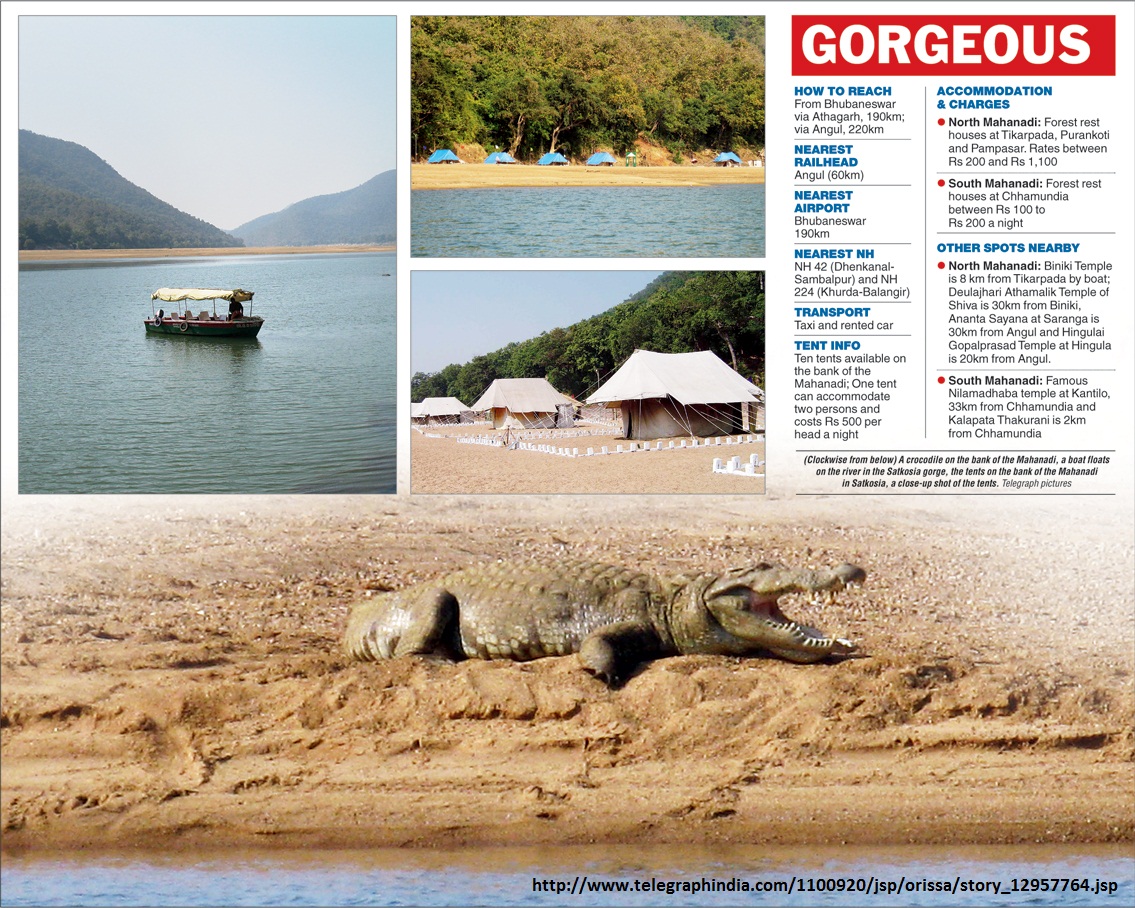Update on the bio-tech park near Bhubaneswar
Following is an excerpt from a Business Standard report in sify.com.
Construction work on the Rs 100-crore Konark Knowledge Park, a biotech-pharma-IT hub, being developed by Hyderabad-based Bharat Biotech International Limited on around 65 acres of land at Andharua on the outskirts of the city, is set to take off by March 2011.
"The biotech park would have all statutory clearances within four months and construction work will begin soon after that", an official source told Business Standard.
… The land leveling for this project is already over and efforts are underway to provide piped water and power supply to the park.
The park is set to be completely operational within eight years of the commencement of construction work.The park would have a Biotechnology Incubation Centre spread over 10 acres. The incubation centre to be developed within the park would cater to the needs of the researchers, entrepreneurs and students.
The Centre would provide equipment called the biotech incubator worth Rs 25 crore for the incubation centre.The biotech industry in the country is growing at a very good pace and this incubation centre is set to emerge as a Centre of Excellence.
The Konark Kowledge Park is the first of its kind venture to be developed on the public private partnership (PPP) mode in the state in the field of science and technology.
… The Industrial Infrastructure Corporation of Orissa (Idco) has been appointed as the nodal agency for the development of this integrated park would provide all external infrastructure facilities like roads, water supply and electricity for this complex.
Bhubaneswar airport aircraft movement, passenger and freight numbers
The following numbers are obtained (with some calculation) from http://www.aai.aero/traffic_news/traffic_news.jsp. (Thanks to Devasis Sarangi for the pointer.)
| Bhubaneswar Airport (BBI) | April 2006 – March 2007 | April 2007 – March 2008 | April 2008 – March 2009 | April 2009- March 2010 |
| Aircraft movements |
7220 | 12270 | 9962 | 10708 |
| Passenger numbers |
351313 | 702199 | 671861 | 825853 |
| Freight (in Tonnes) |
1018 | 1258 | 1287 | 1998 |
The numbers in the last column are not directly in any file in the above site, but were calculated using data in multiple files. No assumptions were made.
The following pages give comparative numbers of domestic passenger traffic in Bhubaneswar airport with respect to other airports in India. Note that the decline from 2007-08 to 2008-09 was across the board. However, the decline of 4.3% with respect to Bhubaneswar airport during that time was much less than the national decline of 11.2% for the same period.
With respect to the above data the domestic passenger traffic in Bhubaneswar is close to the domestic traffic in the international airport of Lucknow and is more than the domestic traffic in the international airports of Trivandrum, Calicut, Amritsar, Port Blair and Nagpur; It is more than the domestic traffic in the custom airports of Mangalore, Trichy, Bagdogra, Varanasi, Patna and Gaya and all other domestic airports that include Indore, Vizag, Vadodara, Jammu, Raipur, Chandigarh, etc.
First phase of the Bhubaneswar City bus to start on October 10 2010: Ad in Samaja
Cabinet Committee on Infrastructure (CCI) approves remaining 600 Kms of State roads in Odisha that are part of the Ranchi-Vijaywada highway
Following is from a PIB release dated 5th October 2010.
Press Information Bureau
Government of India
Cabinet Committee on Infrastructure
05-October-2010 19:48 IST
Upgradation of road from Vijayawada to Ranchi approved
The Cabinet Committee on Infrastructure (CCI) today approved improvement of balance 600 Km. of State roads in Orissa with a view to develop, in a phased manner, the entire 1632 Km. long Left Wing extremism affected Vijayawada-Ranchi corridor at an estimated cost of Rs.1200 crore. The project will be completed in next three years by March, 2014.
The project will also provide a good communication network between the tribal districts of Orissa and other developed areas in the State as well as to the neighbouring States of Andhra Pradesh, Chhattisgarh and Jharkhand.
The project will cover Malkangiri, Jaypore, Rayagada, Gajapati, Ganjam, Kandhmal, Boudh, Sambalpur, Angul, Deogarh, Koenjhar and Mayurbhanj districts in Orissa.
BACKGROUND:
In view of growing activities of Left Wing Extremists in various States, the stretch between Vijayawada-Ranchi Route was considered for development as an integrated project by Central and State Governments. In Sept., 2009, the Government took decision to sanction remaining stretches of National Highways on Vijayawada Ranchi route in Orissa for widening to two-lane standards and undertaking preparation of Detail Project Reports (DPRs) for 600 Km. length of State Roads, which are not covered under any other programme.
***
AKT/SH/SM
Location for Tata power in Naraj is more apt for a Knowledge Park
Following is an excerpt from a report in Expressbuzz.com.
The wildlife wing of the Forest department has raised concerns over the setting up of 1,000 mw thermal power plant proposed by Tata Power Company at Naraj.
Its proximity to critical sites, impact of pollution on them as well as on the wildlife are issues the wildlife wing is worried about. The ` 4,900 cr coal-based power project is proposed at Naraj Marthapur, about 12 km from Cuttack and 20 km from Bhubaneswar.
“The Centre had referred the project site matter to me. Subsequently, I inspected the proposed power plant site and submitted a report in which I have indicated certain concerns relating to environment and wildlife,” Principal Chief Conservator of Forests (Wildlife) P N Padhi said on Monday.
One of the major issues is its location. According to Padhi’s report, the power plant is proposed amidst six critical sites.
It has Bhubaneswar and Cuttack on both sides and it is located between two major rivers __ Mahanadi and Kathjodi.
Besides, it is flanked by two wildlife habitats __ Chandaka- Dampara wildlife sanctuary on the one hand and Nandankanan Zoological Park and Zoo, also a notified sanctuary, on the other.
“With two protected areas (PAs) on its sides, a thermal power plant may have adverse impact on wildlife,” Padhi said. Chandaka, for one, is an elephant sanctuary and has witnessed growing man-animal conflict over the past 10 years.
Besides, the jumbos are known to stray out of their habitats more frequently in the last few years.
Similarly, apprehension of pollution is a major concern …
The power project, which is located in Cuttack Sadar tehsil, needs about 990 acres. It is well close to a road that connects Khurda, Chandaka, Barang and Gobindpur. …
That location (close to Sri Sri University) is apt for a knowledge park. Since the Tatas have already worked hard on the land acquisition Odisha government should tell them that instead of a power plant they should create a Knowledge Park there. It could include a large operation of TCS, a TCS training center like the Infosys center in Mysore, space and infrastructure for multiple universities, medical colleges, etc.
There the total land area is about 990 acres. Currently such an amount of contiguous land is not available so close to Bhubaneswar where one can build IT parks and knowledge parks.
So the Odisha government should consider giving the Tatas some other land for their power plant and use that land for a knowledge park, possibly even built by the Tatas.
Guru Gangadhar Pradhan and Konark Natya Mandap
Following is an excerpt from an article in Deccan Herald.
“My mother-in-law and social worker Sushilavati Swain asked me to start some cultural activity in Konark, so we acquired a piece of land in 1978. Two years later, we built a mud hut and called it the Konark Nata Mandap. Every Sunday we had a meeting and artistes from the nearby areas would come and spend the entire day singing, dancing and playing various musical instruments,” Gangadhar Pradhan says. This created an ambience of culture. The mandap’s activity started in 1980 as a small get-together but soon there was no looking back as it paved the way for the five-day international Konark Dance and Music Festival, that is held every year in this small town of Orissa.
Besides, the Konark Nata Mandap was re-christened Konark Natya Mandap (KNM). It has undergone several changes over the years. And, it has finally taken the shape of the replica of the world famous Sun Temple.
“The festival started in 1986 on the day of Shivaratri. But the seeds of the festival were sown in my mind when I had gone to the Swedish embassy and saw posters of the Khajuraho Festival there. That’s how the idea of the Konark Dance and Music Festival took shape in my mind,” remarks Pradhan.
In the true sense, it was the harbinger of the contemporary festivals of Odisha. “The main objective of the festival is not merely to provide entertainment but to educate and refine. It aims to harmoniously blend the classical, spiritual, tribal and folk aspects of the glorious cultural traditions.”
Built through the painstaking efforts of Gangadhar Pradhan, KNM now is a performer’s delight. A replica of the natyashala of the scintillating and stupendous Sun Temple of Konark, it provides the right kind of ambience for artistes, connoisseurs and art lovers from India and abroad.
The KNM serves as a temple of learning. Following the glorious traditions of Guru Kula Parampara, it provides teaching and training in dance, music, yoga and theatre. Classes on Odissi dance, Gotipua dance, mardal, tabla and Odissi music are being conducted on its premises. Experienced gurus and teachers share their experience with students who get the privilege of presenting their skill on the three stages erected on the premises.
That apart, KNM is functioning as an institution of cultural consultancy in the state for the growth and propagation of Odissi, tradition and classical art forms both at national and international levels. The mandap has shouldered a big responsibility of popularising Odissi dance and the sculptural epic Konark has metamorphosed into a living Konark.
Talking about his dream, Gangadhar Pradhan says that something should be happening in KNM throughout the year. “Now there is a festival happening 220 days in a year.” He is confident of achieving his goal by the middle of this decade.
Explaining about Living Konark, he said that people had seen Konark in stone, now they would see the living Konark and the dancing Konark. Once, this dream materialised, there would be a computerised film on Konark that would be screened.
“When I had given wings to my imagination, I had dreamt of the future 1000 years’ history which takes into account the cultural, spiritual and ritualistic aspects. The triangle of Konark-Puri-Bhubaneswar-Chilka will develop tourism as well as culture. What the tourist sees in one place will not be repeated in other places, so he or she will get to see something new each time,” he added.
Ramachandra Guha: The Congress will have to get rid of family rule; I agree with it.
I agree with his view on Congress as well as BJP. Following are excerpts from an interview of Dr. Ramachandra Guha by Sheela Bhatt in rediff.
Some Congress leaders have mocked Hinduism, sometimes even Hindu civilisation while trying to attract the minorities.
Lots of people have this view of the Congress. I wish we had a political party to challenge the Congress. That would offer the people of India a wider vision of how this country should be built. But we don’t need polarising issues. Such criticism comes from people who have a polarised vision.
I come from Karnataka. In the last election, the BJP put up 224 candidates but not one Muslim. Almost 15 percent of the population of Karnataka is Muslim. So you are telling 15 percent of Karnataka you don’t count for us. Then how can you blame them for voting for the Congress? The BJP originally, said, ‘appeasement of none, recognition of all.’
But they never followed it. In Karnataka they attacked Christians after the Muslims in Gujarat. They had only one woman in the cabinet and she too has been sacked. So what message are they sending?
Is this the alternative to the Congress? The Congress can be a cynical manipulator. It plays one community against the other, okay, but, what are you offering that is better?
Do you think in the coming decades the BJP will form a national challenge to the Congress?
I don’t think so. It has fallen back to the RSS (Rashtriya Swayamsevak Sangh). I think it’s possible that in 20 or 30 years time we may see a new political formation. It is possible a middle-class formation which is not captive of one family or one religion or one caste may emerge.
The BJP had a great chance to become a national party, but it has lost it. During Atal Bihari Vajpayee’s time, even at the time of the last election they had a chance to grow, but they always go back to the RSS.
When the Jaswant Singh crisis happened, (former deputy prime minister and then Leader of the Opposition in the Lok Sabha) L K Advani went to see (RSS chief) Mohan Bhagwat who is head of a social-cultural organisation.
Who will trust the BJP as a young and modern party?
After reading the Congress’s history so well are you surprised by the way in which Sonia Gandhi has taken control of the party in the last ten years? Are you surprised to see the way she has grown and established herself?
I think she is a person of great determination. She has worked very hard. In the revival of the Congress she has been central. But there is a negative side also.
I see that a culture of chamchagiri (sycophancy) has flourished under her. There is a darbari (court) culture, there are chamchas around her. That is not healthy for any democracy.
That is not healthy for the Congress. It is not healthy for India that you have a situation where the prime minister has to come through the Rajya Sabha. He is totally dependent on her. He can not make Cabinet appointments without her approval. I think, there are problems. There are problems in the ways the Congress is run today.
Do you think its basic ideals remain strong today?
I don’t know. I can only say about the Congress is that it is not as bad as its alternatives. It is less bad. You cannot say it’s a healthy, democratic, well-functioning political party.
Look at world leaders like German Chancellor Angela Merkel. How did she come to the top? In democracies political parties have to be open, transparent and secular institutions where anyone can enter. When they put in hard work and talent they can rise.
Look at how Barack Obama and Merkel came up. In the Congress, unless you are close to Sonia and Rahul Gandhi you will not progress. This is well established. We should know that the culture of sycophancy is undemocratic and foreign to the Congress culture. For 80 years the Congress did not function in this way.
Congressmen think that without the Gandhi family they will disintegrate.
Maybe they should have a process of churning and they should rediscover themselves. I can’t say that it’s a happy situation. Because, it amounts to feudalism and it’s not democracy. It is similar to a monarchy where Sonia Gandhi is the queen and Rahul Gandhi is the rajkumar (prince). That is not democratic.
State governments are often biased AGAINST local companies; policies needed to promote start-ups and home grown entrepreneurs
Following is an excerpt from a Business Standard report in sify.com.
The Indus Entrepreneurs (TiE), which is going to start its Orissa chapter soon, has recommended a slew of measures to the Orissa government to give the much needed fillip to entrepreneurship in the state.
TiE has suggested the state government to set up an incubation centre and also put in place a Seed Fund to promote entrepreneurship in a big way.
"I had discussions with the state Chief Minister Naveen Patnaik on creating a conducive atmosphere for entrepreneurship. What we have suggested is that the state can set up an incubation centre for the first generation entrepreneurs and this centre has to be run by competent professionals. Moreover, a Seed Fund has to be created by the state for funding the entrepreneurial ventures", Venkatesh Shukla, member of the board of TiE told Business Standard.
The state government also needs to rope in Non-Resident Oriyas settled overseas to lend their expertise to the upcoming entrepreneurs in the state, Shukla, who visited the state recently, said.
"What I also emphasized during my talks with the Chief Minister that there is an institutional bias against the start-ups and home grown entrepreneurs and this mindset has to be changed as small businesses create nearly 80 per cent of the jobs. For instance in procurement of IT hardware, a level playing field needs to be created for the local entrepreneurs so that they are not eliminated at the pre-qualification stage", he added.
Shukla pointed out that the rules and procedures for the small businesses and the start-ups need to be eased as any FDI (Foreign Direct Investment) no matter how massive it is, can bring sustainable development for the society.
Venk Shukla in other places has given example of what he refers to as "institutional bias against the start-ups and home grown entrepreneurs". I can not locate his exact writing in the subject now, but what he refers to is that in many government tenders there are often requirments that an applying company need to satisfy and such requirement often are such that the local start-ups and home grown entrepreneurs do not satisfy.
As a result two things are happening:
(i) Local start-ups and home grown entrepreneurs are often left behind.
(ii) Corruption creeps in when someone in the decision making decides to favor a local start-up and/or an home grown entrepreneur.
In contrast, in the US various authorities (cities, states, etc.) officially set aside certain percentage of their tenders for business owned by special groups, such as small businesses, minorities, women-owned etc. That way one can legally favor and promote local start-ups and home grown entrepreneurs.
When giving big contracts the authorities may also require that sub-contracts of certain size must be given to home grown entrepreneurs. This is also done in various US jurisdictions. Following are some links that may be useful to look at:
- Maryland small business reserve program: https://www.smallbusinessreserve.maryland.gov/faq/index.cfm.
- USDA subcontracting program: http://www.dm.usda.gov/smallbus/subcontracting.htm.
- US Department of Transportation subcontracting initiatives: http://www.osdbu.dot.gov/Procurement/subcontracting.cfm.
Odisha Single Window Clearance Committee approves new investment of 6500 crores
Following is from a report in Hindu Businessline.
… Orissa government on Friday approved fresh investment of Rs 6,500 crore …
The investment proposals were approved by the Single Window Clearance Committee (SLWCC) meeting chaired by the chief secretary Mr B K Patnaik here.
“The 16 projects approved today will give direct employment to 15,000 people and provide indirect employment for another 25,000 persons,” Industries secretary Mr Sourav Garg told reporters adding that projects worth less than Rs 1,000 crore got clearance from the SLWCC.
Stating that the projects were in cement (4 units), food processing (one unit), manufacturing (one unit), power (one unit), paper (one unit) and steel (five units) sectors …
The name of the companies and additional details are given in this report from Samaja.
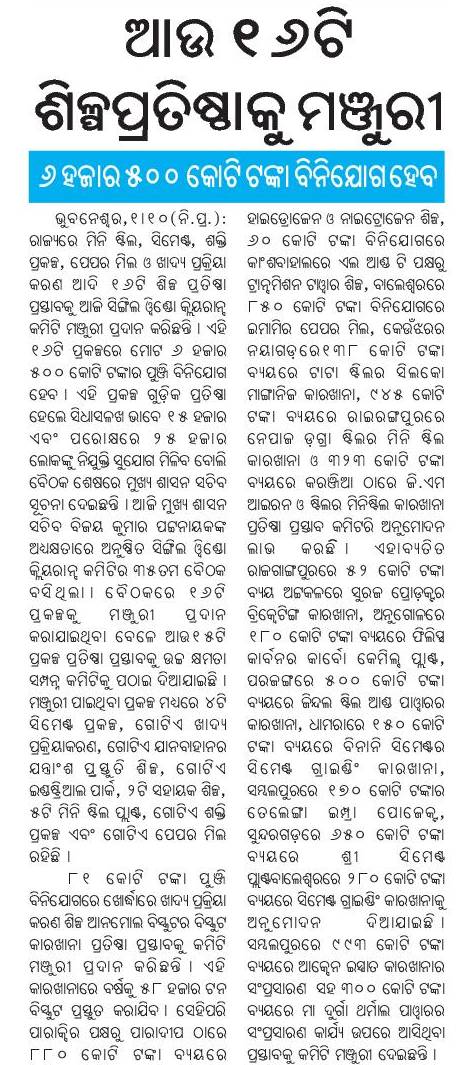
Odisha legislators getting ready early on their request to the Rail ministry
In the past sometimes they would wait till January and sometimes they would forget until a few days before the rail budget. But this time they seemed to be prepared ahead of time. Following is a report from Dharitri.
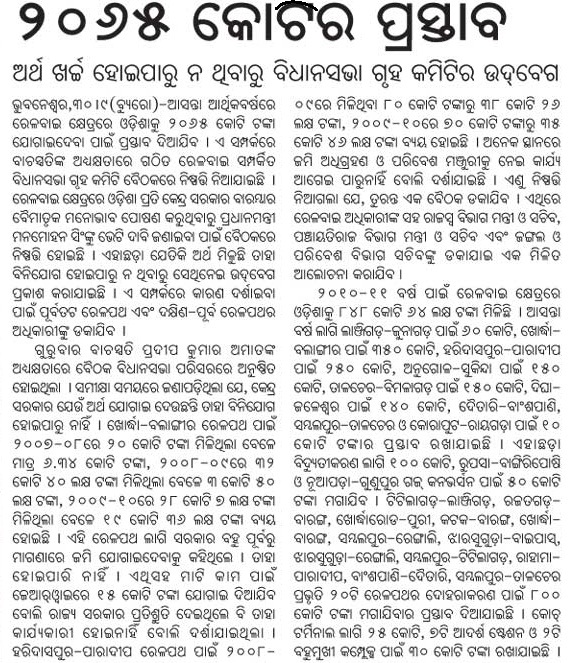
Civil Aviation Ministry responds negatively to Odisha’s request to make Bhubaneswar airport an international airport and is in deadlock with respect to the Jharsuguda airport: article from Sambada
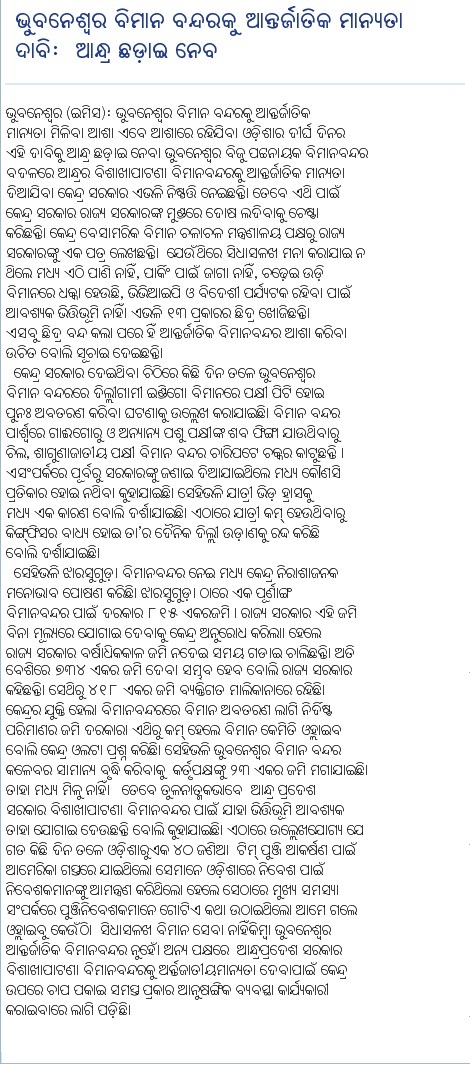
My position is that the ministry is most welcome to make Vizag an international airport; but it should not deprive Bhubaneswar the same. Since the above article pokes holes on Bhubaneswar’s claims for international designation and explicitly mentions Vizag, hence my following attemp to compare the two in terms of daily non-stop flight connectivity. I used http://www.cleartrip.com and used the dates of 18th and 26th Novmeber. (This is an initial attempt. If I missed something please let me know.)
| Bhubaneswar | Visakhapatnam | |
| Delhi | FIVE: 5 daily non-stop flights (Indigo – 2, Kinfisher Red -2*, Air India) | TWO: 2 daily non-stop flights (Jet Konnect, Air India) |
| Mumbai | Two: 2 daily non-stop (Kingfisher Red, Air India) | Zero non-stop flights |
| Kolkata | FOUR: 4 daily non-stop flights (Kingfisher Red – 2, Jet Konnect – 2) | ONE: 1 daily non-stop flight (Jet Konnect) |
| Chennai | ONE: 1 daily non-stop flight (Air India) | THREE: 3 daily non-stop flights (Kingfisher Red, Air India, Jet Konnect) |
| Hyderabad | TWO: 2 daily non-stop flights (Indigo) | SIX: 6 daily non-stop flights (Jet Konnect, Spice Jet 2, Kingfisher Red 2, Air India) |
| Bangalore | ONE: 1 daily non-stop (Kingfisher Red) | ZERO: No daily non-stop flight |
| Total metro connectivity | 15 daily non-stop (only three are by Air India; rest are by private airlines) | 12 daily non-stop (only three are by Air India; rest are by private airlines) |
| Others | ? | ? |
| Airlines operating now | Air India, Indigo, Jet Konnect, Kingfisher Red | Air India, Jet Konnect, Kingfisher Red, Spicejet |
* The Kingfisher Delhi-Bhubaneswar flights are canceled for now, in November they show twice a day and in some December dates they show once a day. Its exact schedule is at http://www.flykingfisher.com/Flex/schedules.pdf. There it shows the following:
Delhi (DEL) IT 3346 19:30 21:25 320 0 03 Oct 2010 24 Oct 2010 7 Kingfisher Red Service
Delhi (DEL) IT 3346 20:30 22:40 320 0 31 Oct 2010 22 Mar 2011 1,2,3,4,5,6,7 Kingfisher Red Service
Delhi (DEL) IT 3350 09:10 11:20 320 0 31 Oct 2010 22 Mar 2011 1,2,3,4,5,6,7 Kingfisher Red Service
Bhubaneswar (BBI) IT 3345 17:05 19:00 320 0 03 Oct 2010 24 Oct 2010 7 Kingfisher Red Service
Bhubaneswar (BBI) IT 3345 17:45 19:55 320 0 31 Oct 2010 22 Mar 2011 1,2,3,4,5,6,7 Kingfisher Red Service
Bhubaneswar (BBI) IT 3349 06:30 08:40 320 0 31 Oct 2010 22 Mar 2011 1,2,3,4,5,6,7 Kingfisher Red Service
That is it will have twice daily flights between Bhubaneswar and Delhi.
Some other comparative numbers:
- As per http://pib.nic.in/release/release.asp?relid=55629 average number of flights operated in a day from Bhubaneswar is 50 and from Vizag is 33.
- As per the world-gazetteer the population of the Bhubaneswar metropolitan area is 1,696,807 and the population of the Vizag metropolitan area is 1,534,162.
On Jharsuguda airport there seems to be a deadlock. It is clear that the center wants 815 acres land and the state is offering only 734 acres.
Why is not the state giving the amount of land the center is asking for? Is there some genuine reason behind it? I don’t know. Perhaps someone who knows can help.
Also is the amount of land that the center is asking an absolute must? Are there other operational airports with less land? (I don’t know.) Ofcourse more land would mean a bigger airport. But is not it possible to use the land the state is giving to make the airport and then pursue the additional land for future expansion.
Update: Just did some search and found that:
- Patna airport covers an area of only 254 acres.
- Varanasi airport covers an area of 582.5 acres.
- Trivandrum airport is a 583 acres campus.
- Tirupati airport: Currently at 293 acres and will grow to 690 acres.
- Dibrugarh airport: 253.96 acres.
- Jaipur airport: 716 acres.
- Tiruchi airport: 702 acres.
- Jammu airport: 88.7 acres. (??)
- Srinagar airport: 52.6 acres. (??)
- Ranchi airport: 526 acres.
Outside India there are some very busy airports that have around 700 acres of land. For example:
- La Guardia Airport in New York is 650 acres. (It is next to a river through.)
- In 2008, 176,373 flights departed LaGuardia. That makes it an average of 483 flights a day.
- Reagan National Airport in Washington DC is 733 acres. (It is also next to a river.)
World class Locking and Popping makes Berhampur’s Harihar Dash the second finalist from Odisha in India’s Got Talent Khoj (Season 2)
Update: He did a wonderful performance in the finals and got 27 points from the judges (9+8+10), but did not win. The winning team got 28 (=9+9+10) points from the judges.
This year there are two (out of 9) finalists from Odisha in India’s Got Talent Khoj (Season 2). [Last year Prince dance group from Berhampur, Odisha was the champion.] One of this year’s finalist is the fabulous sand animation group. Earlier we wrote about them. While they made it to the finals through the wild card round, Harihar Dash from Berhampur made it to the finals directly from his semifinal round for his world class locking and popping dance and it looked like his was the most vote getter from that round. Here are his youtube videos.
Semifinal:
Quarterfinal:
Audtion:
Performance from college days:
New investments and investment projects under implementation
Following is from a Business Standard report in sify.com.
Orissa has continued its growth momentum as a favourite destination for investors attracting investments worth Rs 98,929.49 crore in the April-June period of this fiscal. The most of these new investment proposals are in sectors like power, steel, cement, food processing and downstream industries.
The single largest investment proposal of Rs 45,000 crore has come from Strategic Energy Technology Systems Pvt Ltd for a coal to liquid project at Angul on May 12, 2010.
The bulk of the investments- Rs 33,569.25 crore has been proposed in the power sector with proposals for setting up of Independent Power Plants (IPPs) with a cumulative capacity of 7740 MW.
Ferro Alloys Corporation (FACOR) Power Limited has proposed to set up a 270 MW (2×135) coal-based thermal power plant at Haridaspur in Jajpur district. Similarly, KU Projects intends to set up a 1320 MW (2×660) power plant at Thakurpur in Sonepur district at an investment of Rs 7260 crore. This project has been cleared by the High Level Clearance Authority (HLCA) of the state government.
Similarly, Shivani Thermal Power Station of Ghaziabad (Uttar Pradesh) has proposed to set up a 1320 MW (2×660) power plant at Chhotapadagan in Cuttack district at a cost of Rs 7554.54 crore.
Visa Power has submitted a revised proposal to the state government owned Industrial Promotion and Investment Corporation of Orissa Ltd (Ipicol) to set up a 1320 MW (2×660) power plant at Brahmanabasta in Cuttack district, entailing an investment of Rs 6319.48 crore.
Shri Anant Infra Energy Pvt Limited has evinced interest to set up a 210 MW coal-based power plant at Garjan Bahal in Sundergarh district.
Responsive Industries Ltd has proposed to set up a 1320 MW (2×660) power plant at Manmunda in Boud district at a cost of Rs 6487.50 crore.
CLP Power India Pvt Ltd plans to set up a 1980 (3×660) MW power plant at Majhapada in Sundergarh district at a cost of Rs 10,000 crore.
Among the investment proposals in the cement sector, Kolkata-based Icore Super cement Ltd has proposed to set up a cement plant at Somnathpur in Balasore district at an investment of Rs 151 crore.
While Ramco Industries Limited has evinced interest to set up a 120,000 tonnes per annum asbestos fibre cement sheet plant at Jharsuguda at a cost of Rs 35 crore, Madras Cement intends to set up a 4000 tonne per day cement plant at Nandibera in Malkangiri district at a cost of Rs 750 crore.
Reliance Cementation Ltd has submitted proposal for a 2.8 million tonne per annum cement plant at Jallangbara in Sundergarh district at a cost of Rs 970 crore.
Similarly, Binani Cement plans to set up a one million tonne per annum clinker grinding unit at Dhamara in Bhadrak district at a cost of Rs 130 crore.
In the steel sector, Rashmi Metalliks Limited has proposed to set up a three million tonne per annum pelletisation plant and 44 m captive power plant at Baliarpur in Bhadrak district at an investment of Rs 3465 crore.
The Orissa Minerals Development Company Limited has evinced interest for a two million tonne per annum beneficiation and pelletisation plant at Dalki in Keonjhar district at a cost of Rs 889 .
Following is excerpted from a report in indiainfoline.com.
The statewise breakup of investment under implementation as on June ’10 (Rs. Crores) has been Maharashtra (666065), Orissa (498190), Gujarat (487361), Andhra Pradesh (478612), Tamil Nadu (334960), UP (326356), Haryana (318488), West Bengal (288109), Karnataka (279033), Jharkhand (173008), Chhattisgarh (167557), Madhya Pradesh (165848), Kerala (126223), Punjab (115683), Rajasthan (84955), Bihar (59339), Jammu & Kashmir (44339), Himachal Pradesh (43928), Uttrakhand (38869), Assam (36124).
… The capital goods industry’s performance is mainly on account of spurt in investment activity in Haryana, UP, Kerela, Orissa and Uttarakhand in the first quarter of 2009-10.
… The rate of implementation (% share in total live investments) as per June 2010 in prominent states, has been the most in Haryana (81.5) followed by UP (70.6), Assam (65.9), Maharashtra (61.7), Punjab (60), Andhra Pradesh (58.5), Himachal Pradesh (56), Jammu & Kashmir (53.1), Kerala (51.9), Bihar (50.5), West Bengal (49.4), Tamil Nadu (47.7), Orissa (44.3), Chhattisgarh (40.6), Madhya Pradesh (40.2), whereas states like Uttrakhand (39.1), Gujarat (38.9), Rajasthan (34.7), Karnataka (32.7) and Jharkhand (28.2) are lagging behind in this aspect.
Camping on the riverbed in Satkosia: a Telegraph travel report
The full article by Bibhuti Barik is at http://www.telegraphindia.com/1100920/jsp/orissa/story_12957764.jsp. Following is the graphic from that article.
Progress on Subarnarekha port (earlier referred to as port at Kirtania)
Following are reports from Samaja and Dharitri. It says land has been selected in the Choumukh panchayat. The port, which was earlier referred to as Kirtania port, is now referred to as Subarnarekha port. The Samaja article mentions that for the port connectivity there will be a two lane road and rail lines between Haldipada and Choumukh. The Daharitri article mentions the rail points as Rupsa and Jaleswar. Both articles say that if things go as planned the port should be operational by 2014. This port is being made by Creative Ports of Chennai.
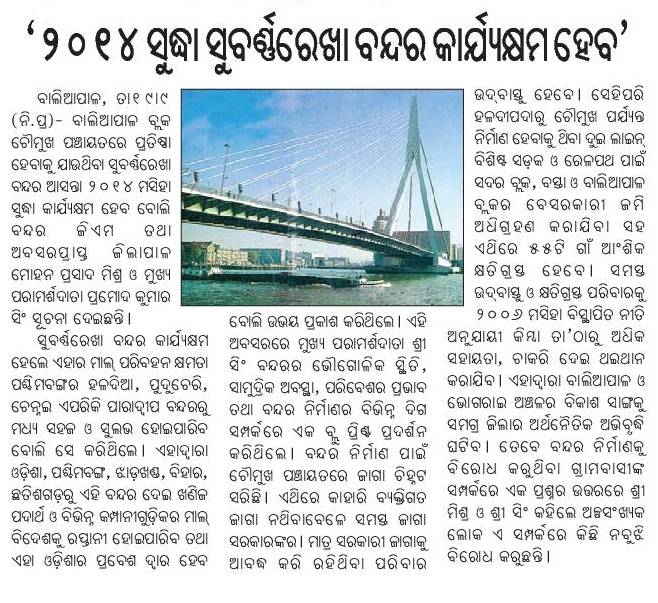
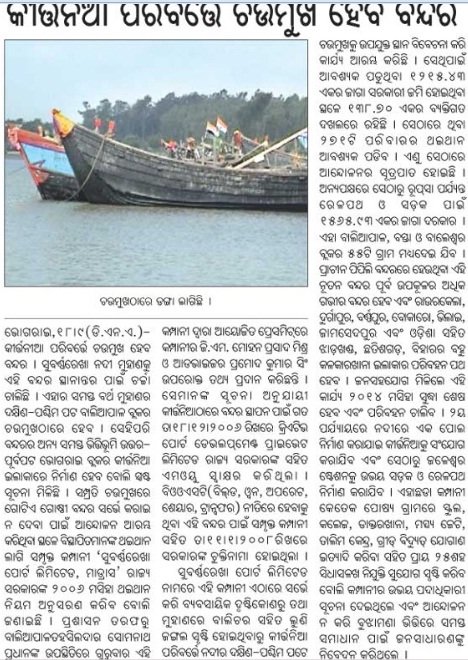
Odisha plans to revive the lower Suktel project
Following is an excerpt from a report in orissadiary.com.
The Chief Minister Naveen Patnaik has reviewed the progress of lower Suktel Irrigation Project in the Orissa Secretariat on Saturday , which is under construction in Balangir and Sonepur district. The Chief Minister instructed the departmental officers to speed up the construction work of the project.
As per the information in the meeting, about Rs 1041.81 crores will be expended for the project and more than 31,830 cultivable land of Balangir and Sonepur district will be irrigated by the project. Out of which 29,850 Hector of Balangir district and 1980 Hector of Sonepur district. The phase II (stage II ) forest permission has been sanctioned . The land acquisition work for the project is going on. It has been decided to complete the land acquisition work by the month of October. Two officers will be engaged for the purpose.
The following PTI report from ibnlive gives addition information on this.
The project having potential of irrigating about 31,830 hectare of land in Balangir (29,850 hectare) and Sonepur (1980 hectare) districts, would have 1230 square km of catchment area. Earthen dam of 1410 meter was required to be built for the project.Of the total 29 villages to be affected, 16 villages to be fully submerged due to the dam prorject. Other 13 villages would be partially affected, they said adding that the state government had decided to rehabilitate the people according to the norms of the state government’s Rehabilitation and Resettlement (R&R) policy-2006.To rehabilitate 1266 families belonging to four villages, rehabilitation colony was being developed while the government had identified two other places to settle others, they said. In Bolangir-Sonepur districts, irrigation potential is only three per cent which is lowest in the world, official sources said adding that there was no major irrigation project in Balangir.As Balangir receives scanty rainfall, the district faces acute drinking water problem besides water to the agricultural land.
Status of Essar Steel projects in Odisha
Following is from a report in Orissadiary.
The 6-million tonne Essar Steel pellet plant here will be made operational by October this year. The `2,200-crore project includes an 8-MT ore beneficiation plant at Joda and Barbil and a 250-km slurry pipeline from Joda to Paradip. The company plans to expand the beneficiation and pellet manufacturing capacities to 12 MT in the future.
Initially, the company will source iron ore from private mines at Joda and Barbil. However, the company expects that the State and Central Governments will grant it lease for a captive mine in the long run.
The pellets to be produced at Paradip would be exported through the Paradip Port to Essar’s steelmaking unit at Hazira in Gujarat, which is undergoing a capacity expansion to 9.6 MT from 4.6 MT by 2012, said sources.
Following is excerpts from an interview in Business Standard. The investment numbers mentioned there does not quite gel with the numbers mentioned above.
Is there a time frame for realising the long-term vision?
It arises from the commitments, as well as MoUs (memorandums of understanding) with various state govts. These are linked to raw material. It’s a chicken and egg story. You need the raw material, otherwise you are not going to invest. We have our plans in Jharkhand, Chhattisgarh. In Orissa, we are already completing the first phase. In Karnataka, we have signed the MoU and the government is looking to provide land. But we also want the mines. We don’t want to create a situation where all the investments are done and then you say the mines are not available.
The Orissa government has a clause in the MoU that the state will recommend mines once you have made commitments for 25-30 per cent.
Yes, commitments have to be made, which implies it could be orders. But a 12-million tonne plant will cost anything between $12 billion and $15 billion. Thirty per cent of that will be $4.5 bn. How can anyone expend $4.5 bn in the hope that one will get the mines? It’s easier for smaller players.
Indian Express article on Polavaram dam
The following are excerpts from an article by Sreenivas Janyala in Indian Express.
… Polavaram dam, a dream project for the state and a potential flashpoint involving its neighbours, Orissa and Chhattisgarh. The idea of the dam was first floated in the early 1940s but it remained a dream for the state government, an ambitious venture that stayed on election manifestos. So for years, the Godavari flowed almost unharnessed, emptying itself into the Bay of Bengal. It was only when Y S Rajasekhara Reddy took charge in the state that the Polavaram project was revived, as part of his Jalayagnam programme.
The 150-feet-high dam, called the Polavaram Indira Sagar Dam, will create a reservoir spreading over the three districts of West Godavari, East Godavari and Khammam. The tail-end of this reservoir is more than 150 km away, touching Bastar in Chhattisgarh and Malkangiri in Orissa. The dam will harness 170 thousand million cubic feet water (tmcft), through two canals that spread out as arms on either side: the right canal which will take 80 tmcft to river Krishna and the left canal, which will help irrigate 7.2 lakh acres in the north coastal Andhra districts and take 23 tmcft to Visakhapatnam, which faces a perennial water shortage. Work on the dam has not yet begun but the cranes are furiously at work on the left and right canals.
The dam, a Rs 11,000-crore project, will be an earth-cum-rock fill structure as the soil isn’t rocky enough for a concrete dam.
The Polavaram dream
For nearly 60 years, Polavaram remained on paper, dogged by controversies of displacement. Now, the state’s neighbours, Orissa and Chhattisgarh, have dragged it to the Supreme Court, saying the dam would inundate several parts of their states. According to government estimates, the dam will submerge villages in the three Andhra districts of West Godavari, East Godavari and Khammam, in Bastar in Chhattisgarh and in Malkangiri, Orissa. Besides, nearly two lakh people will be displaced.
But in a state that’s divided over the Telangana issue, the dam has brought together all political parties, including Chiranjeevi’s Praja Rajyam and Chandrababu Naidu’s TDP. With the Environment Ministry having cleared the project on September 5, the government is in a hurry to start work.
“This is an ambitious project that will solve the irrigation and drinking water problems over a large area. Our relief and rehabilitation package is the best in the country.
… the state government says it wants to finish the project in four years. In its zeal to take the project ahead, the state government has given some lofty assurances to the Centre, including the construction of a 60-km-long, 45-feet-high embankment to prevent flooding in neighbouring states.
The concerns
Like all big dams, Polavaram is dogged by the dam versus displacement problem. Chhattisgarh and Orissa, the two states that are opposed to the dam, say the project will submerge large tracts of tribal and forest land and displace primitive tribals who are dependent on the forests. Both states say that if the project has to go ahead, it has to be redesigned and fresh assessments and estimates made. Both states have also rejected the Andhra Pradesh government’s proposal to construct a 30-km-long embankment at the reservoir’s tail-end to prevent submergence in those states.
Orissa is also upset that the environment ministry has cleared Polavaram when its own big-ticket projects, like Niyamgiri, weren’t.
Orissa says 10 villages in Motu tehsil, nine of them dominated by Koya tribes, will be submerged in Malkangiri district. “A population of 6,000 is going to be affected, which includes Scheduled Tribes and Primitive Tribes. Andhra proposes to build an embankment to prevent these 10 villages from getting submerged. But that is unrealistic. The embankment has to be 30 km long and 45 feet high and has to be constructed inside Orissa. Who is going to acquire land to build this wall? What is the environmental impact? Has any assessment been done? A bigger question is, if an embankment is built, where will rain and flood water go from Orissa’s side? It will end up flooding 100 other villages in Malkangiri,” says Suresh Chandra Mahapatra, Commissioner and Secretary, Water Resources Department, Orissa.
In Konta tehsil of Bastar in Chhattisgarh, 23 villages will be submerged. Bastar Commissioner B Srinivasulu too calls the embankment “a far-fetched idea”.
While there is no political opposition to the dam in Andhra Pradesh, environmentalists and human rights activists are opposed to it, saying it will displace more people than the Sardar Sarovar Project on the Narmada river.
In Andhra, 277 villages in Khammam, East Godavari and West Godavari districts, parts of the Papikonda hills and wildlife sanctuary and 3,000 acres of forest land will go down under. The activists say the livelihood of thousands of Godavari fishermen is at stake and the primitive Koya and Kondareddi tribes in Khammam district would be displaced.
… There are other worries too. The Central Water Commission had approved the design based on initial estimates that the spillway (the structure that provides the controlled release of excess water) could withstand 36 lakh cusecs of flood discharge. It was later revised to 50 lakh cusecs. But recent rainfall trends and flood history predict a peak flood of 80 to 90 lakh cusecs and that could wash the dam away, says T Hanumantha Rao, former chief engineer and UN consultant.
Rao says he is not against the Polavaram project but warns against the flooding. “Andhra needs a project like Polavaram. But large earthen dams are prone to breaches. If the dam overflows, it will cause breaches. Polavaram is located at the end of the river where the peak discharge of the river occurs. Only four other rivers in the world have flood peaks more than Godavari and none of them have earthen dams where such peak flood flows occur,” he says.
Last year, two earthen dams in Andhra developed breaches during the monsoons—Gundlavavu in Warangal and Palamvavu in Khammam district.
Then, there is the debate over the height of the dam. While Orissa and Chhattisgarh are objecting to the proposed 150-feet-high dam, Andhra says the purpose of the dam is defeated if it is anything less.
Odisha plans for a state-specific SEZ policy
Following is an excerpt from a report in Business Standard.
Under the proposed SEZ Policy, the state government shall not encourage SEZs based on mining and minerals like iron ore, chrome ore and bauxite. However, SEZs based on the use of intermediate products like alumina for smelting, primary metals for further processing on the value chain and rare minerals like tin, limenite, nickel, platinum and vanadium will be allowed.
Moreover, the state shall not encourage SEZs based on activities like mining that cause pollution. The Orissa State Pollution Control Board shall prepare a list of such industries and the same would be notified by the state government as a negative list.
The mineral based SEZs already approved shall undertake to develop and promote related downstream industrial complexes over a minimum area as prescribed by the Government of India. In the event of non-compliance of this condition, all state concessions shall be withdrawn.
The State Level Single Window Clearance Authority (SLSWCA) shall be the competent authority to screen and recommend SEZ proposals irrespective of the magnitude of investment.
All recommendations of SLSWCA would be placed before the High Level Clearance Authority for approval before making any recommendation to the Government of India.
The state government owned Industrial Promotion and Investment Corporation of Orissa Limited (Ipicol) would function as the state level nodal agency for receipt, scrutiny and placement of the applications before the SLSWCA.
For sector specific projects, the respective nodal agencies like the Orissa Computer Application Centre (OCAC), Industrial Infrastructure Corporation of Orissa Limited (Idco) and Agricultural Promotion and Investment Corporation of Orissa Limited (Apicol) will receive and scrutinize the applications.
As per the SEZ Policy of the state, the import of goods and services made to SEZ units located within the processing zone from the Domestic Tariff Area shall be exempted from Value Added Tax (VAT), entry tax, electricity duty and other cess payable on sales and transactions.
The SEZ Policy of the state has not envisaged any special provisions for backward districts like Kalahandi, Bolangir and Koraput and tribal dominated areas.
Till now, four SEZs have been notified in the state– the sector specific IT/ITes SEZ at Chandaka Industrial Estate in Bhubaneswar developed by Idco, sector specific SEZ for stainless steel and ancillary downstream industries at the Kalinga Nagar Industrial Complex being developed by JSL, aluminium and aluminium products SEZ at Lapanga near Sambalpur being developed by Hindalco Industries and another aluminium SEZ with Captive Power Plant being developed by Vedanta Aluminium Limited at Jharsuguda.
Some of the other Orissa related SEZs plans and approvals that are not mentioned in the above article are (see also http://www.orissalinks.com/orissagrowth/archives/1305):
- Recent approval of IT/ITES SEZ of Suryo Infra. in Bhubaneswar.
- Approval of Solar SEZ by Lanco Solar in Ramdaspur Cuttack.
- Proposal by Geetanjali gems and minerals.
- Work has started for theTATA SEZ in Gopalpur.
- POSCO SEZ in Paradip (Dec 2009: asked to file fresh proposal).
- Saraf Agencies SEZ for Titanium in Chhatrapur (Saraf pulls out; Odisha asks Russian company to speed-up; perhaps no longer an SEZ.)
- Wellspun garments SEZ in Choudwar: 200 acres (??)
Investment pouring in to Paradip: Nageshwar Patnaik in Economic Times
Following are extracted from his article in Economic Times.
- The port town in Jagatsinghpur district, about 120 km from the state capital of Bhubaneswar, has already emerged as one of the country’s major investment hotspots by attracting investment in excess of Rs 3.5 lakh crore including the Rs 2, 74,134 crore Petroleum Chemicals and Petrochemical Investment Region (PCPIR) and the biggest FDI proposal by Posco to build a 12-million ton steel plant at an estimated cost of Rs 51, 000 crore.
- The port town already boasts of major fertilizer manufacturers like IFFCO and Paradeep Phosphates Limited, a brewery along with central depot of Indian Oil and other small industries like Kargil Oil, Paradeep Carbon and a host of other units.
- … an integrated Petroleum, Chemicals, and Petrochemical Investment Region (PCPIR), a Special Purpose Vehicle (SPV) promoted by the state government on the lines of Pudong in China, Rotterdam in Europe and Houston in North America.
- IOC is already coming up with 15 MMTPA grassroot refinery cum petrochemical complex five kilometer to the south of Paradeep Port at an estimated cost of Rs 25,646. For this, the state government has given incentives to IOC by exempting entry tax on crude oil and sales tax deferment for 11 years. The IOC already has got the required 3344 acres of land.
- The Railways is also committed to boost connectivity in the Paradeep region which includes the 82-km Paradeep-Haridaspur broad gauge line, being taken up at an investment of Rs 577.78 crore. East Coast Railway (ECoR) has acquired 1,146 acres of private land out of the total of 1,653 acres of land required for the project. This project being implemented by Rail Vikas Nigam Limited (RVNL) is scheduled for completion by March 2011.
- The other projects in different stages of implementation Hydrate Pellets Ltd’s six lakh tone hydrate pelts plant at Rs 10,724 crore, Essar Steel Orissa Ltd’s six million ton steel plant at Rs 10,721 cr], Deepak Fertilisers and Petrochemicals Corporation Ltd. (DFPCL’s three lakh mtpa green-field complex for Nitric Acid and Ammonium Nitrate at Paradeep at a cost of Rs 400 crore NSL Sugar Ltd’s sugar plant at Rs 800 crore and other mini projects.
One other thing that is not elaborated in the article is that as part of the PCPIR several things will be funded by the state government and several other things will be funded by the central government.The following is excerpted from an older article in Business Standard.
- “The Centre would provide this money in two phases. While Rs388 crore would come in the first phase of the project, the balance Rs328 crore would be provided by the Government of India in the second phase”
- … six-laning of NH-5 (A), building a greenfield coastal corridor, construction of all-new greenfield road from Bhubaneswar to Paradip and upgradation of port infrastructure.
-
The six-laning of the NH-5 (A) will be taken up in the second phase of the PCPIR project at a cost of Rs76 crore. The greenfield coastal corridor will involve an expenditure of Rs410 crore out of which Rs 264 will be invested in the first phase while the remaining expenditure of Rs146 crore will be incurred in Phase-II.
-
The construction of all-new greenfield road from Bhubaneswar to Paradip will be taken up at a cost of Rs190 crore while Rs40 crore would be provided by the Centre for upgradation of port infrastructure.
-
Meanwhile, the Orissa government has committed an expenditure of Rs1796 crore on infrastructure development for the PCPIR hub. Out of the envisaged expenditure of Rs1796 crore, Rs 754 crore will be spent on development of arterial roads, Rs 465 crore on water supply, Rs 410 crore on power distribution and Rs136 crore on canal upgradation.
To match these industrial investments in Paradip, the Odisha government needs to make plans for a university, an engineering college and a medical college for this area. Similar plans need to made for the other upcoming industrial hubs at Angul, Kalinganagar, Jharsuguda and Rayagada; as well as the only existing industrial area of Rourkela which neither has a medical college nor has a regular university.
Peerless plans a 4 star hotel in Bhubaneswar
Following is an excerpt from a report in Telegraph.
Peerless Hotels is looking for land to set up four-star facilities in Bhubaneswar, Noida and Navi Mumbai, according to a senior official of the company.
“Our negotiations with the Orissa government for the Bhubaneswar project are at an advanced stage, and if we get the land that we have chosen, the construction of the 80-room hotel will start in another one year,” Peerless Hotels chief executive officer Kunal Sen said.
… “The setting up of a four-star hotel with 80-100 rooms entails an investment of between Rs 75 crore and Rs 95 crore, including land cost that may be between Rs 15 crore and Rs 35 crore depending on location,” Sen said.
Paradip port trust plans an airstrip
Following is an excerpt from a report in Steelguru.com.
Paradip Port Trust is planning to have an airstrip within the port premises to facilitate movement to and from the port.
A resolution in this regard was recently passed by the board of trustees of the port. Mr Biplav Kumar chairman of PPT told Business Line that "We’ve also received in-principle consent of the Shipping Ministry.”
… The land for the proposed airstrip, as the port Chairman informed, has been identified.
Since the PCPIR in Paradip has been approved, I expect this airstrip will be established soon.
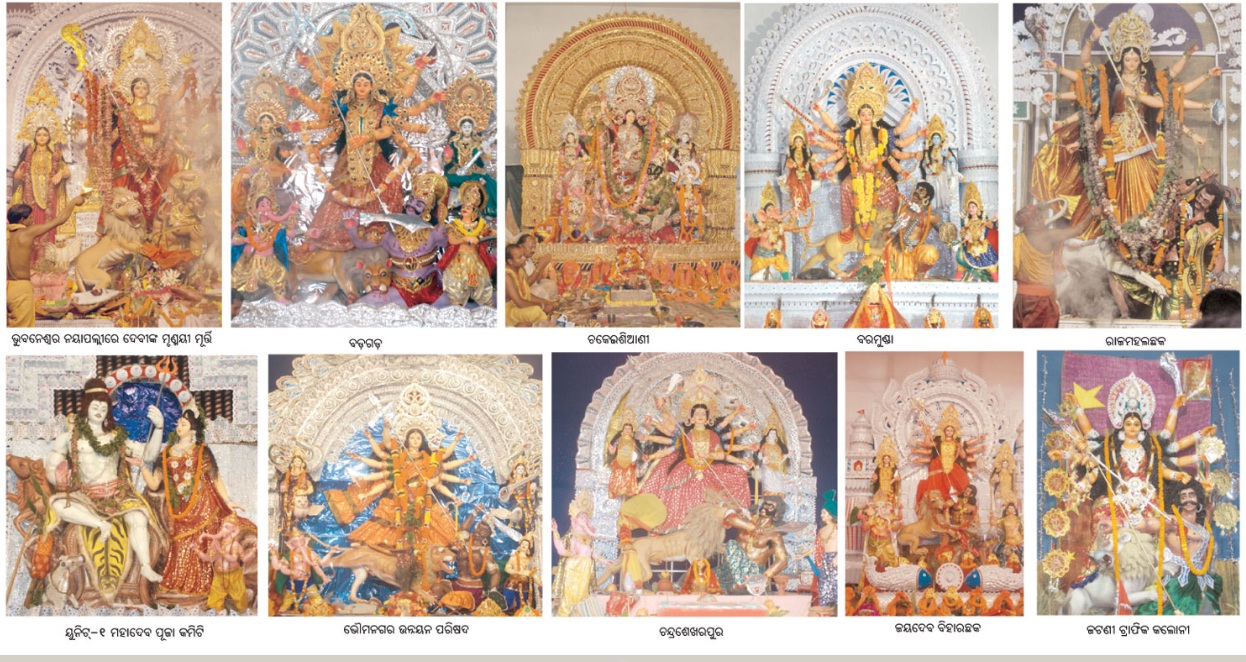
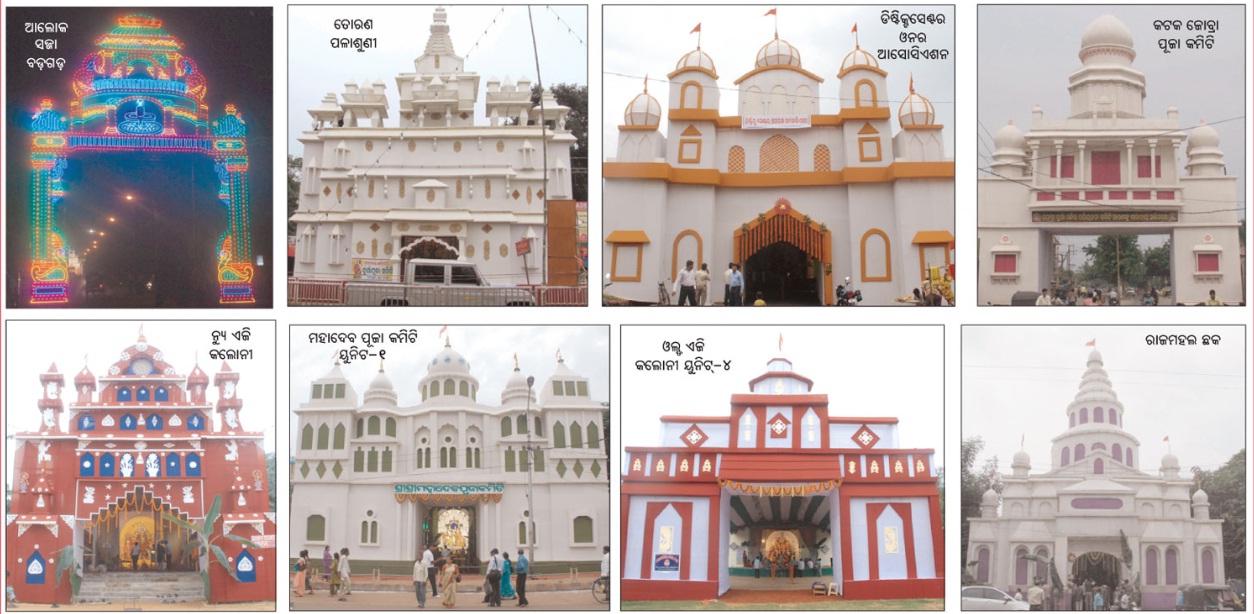
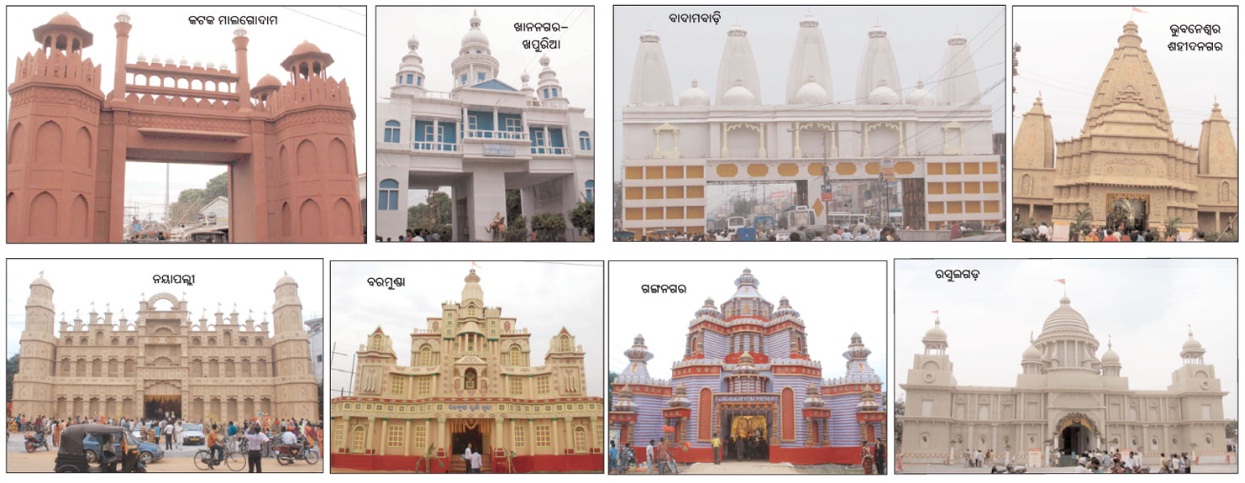
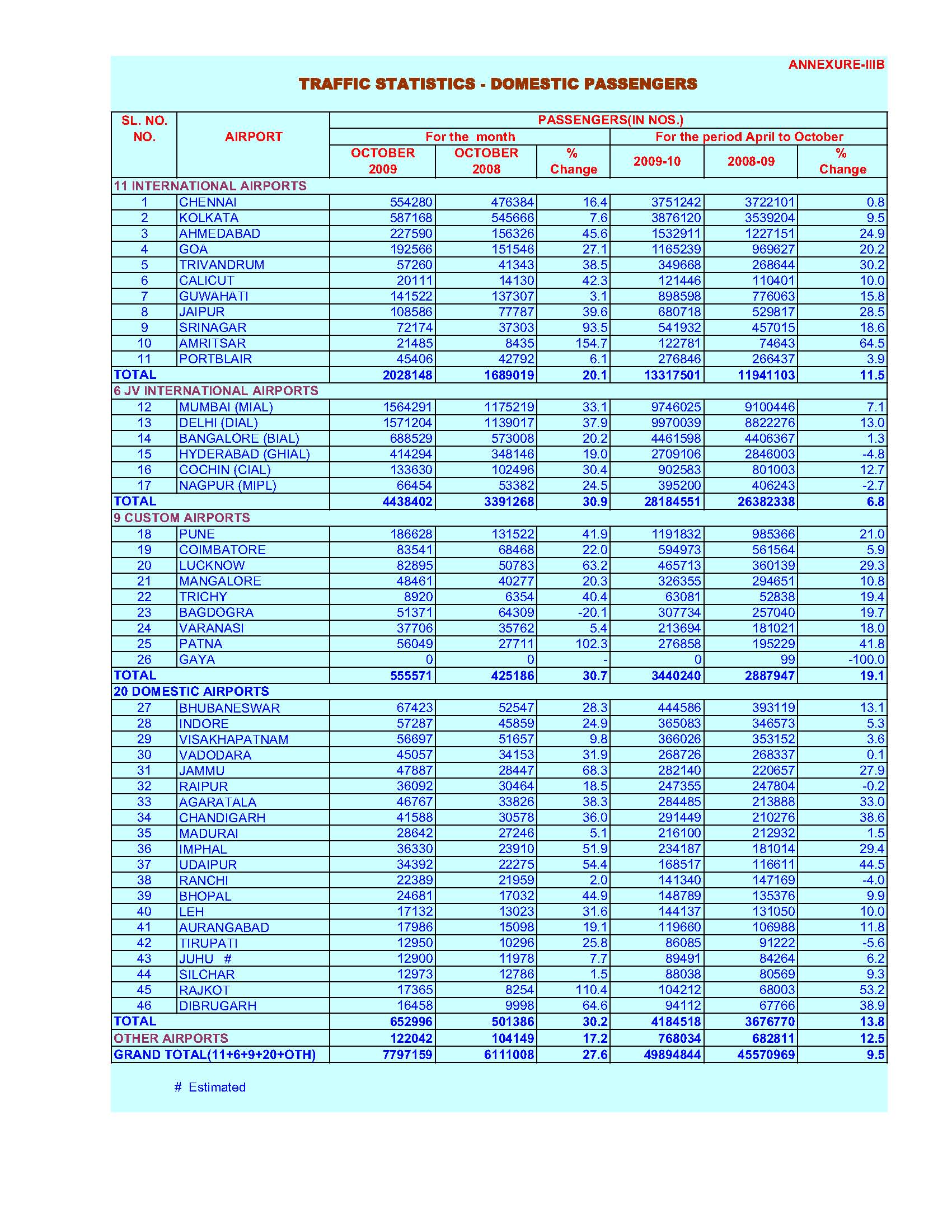
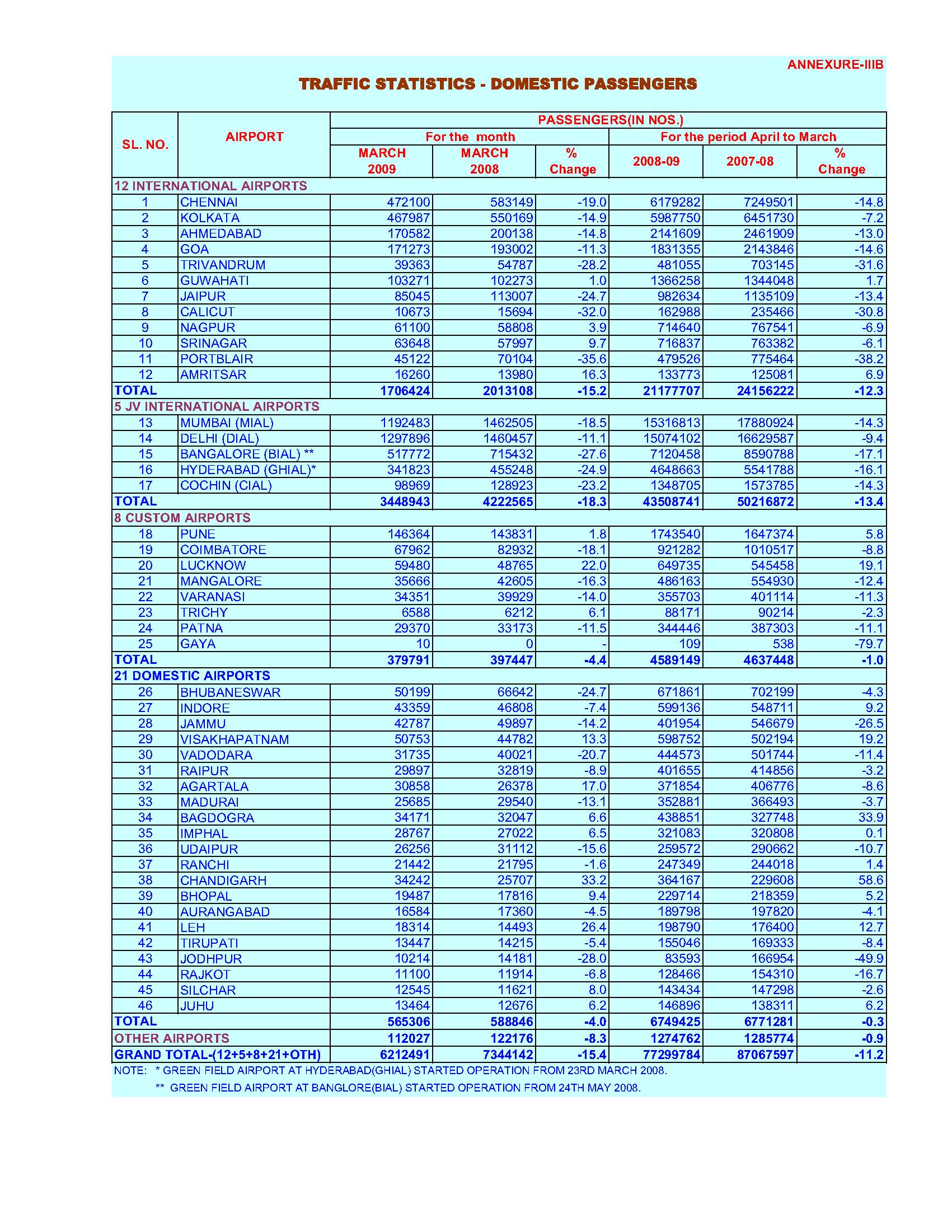
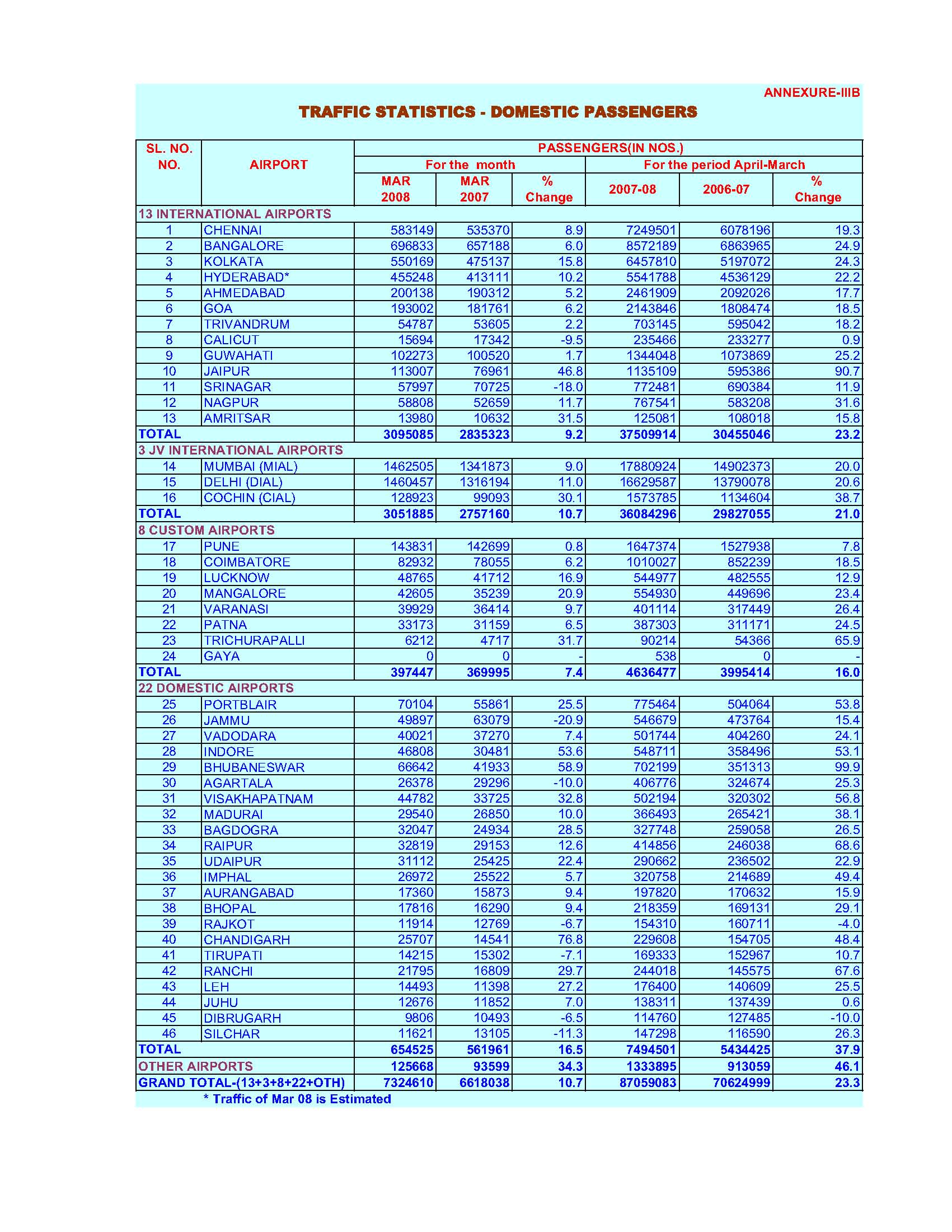
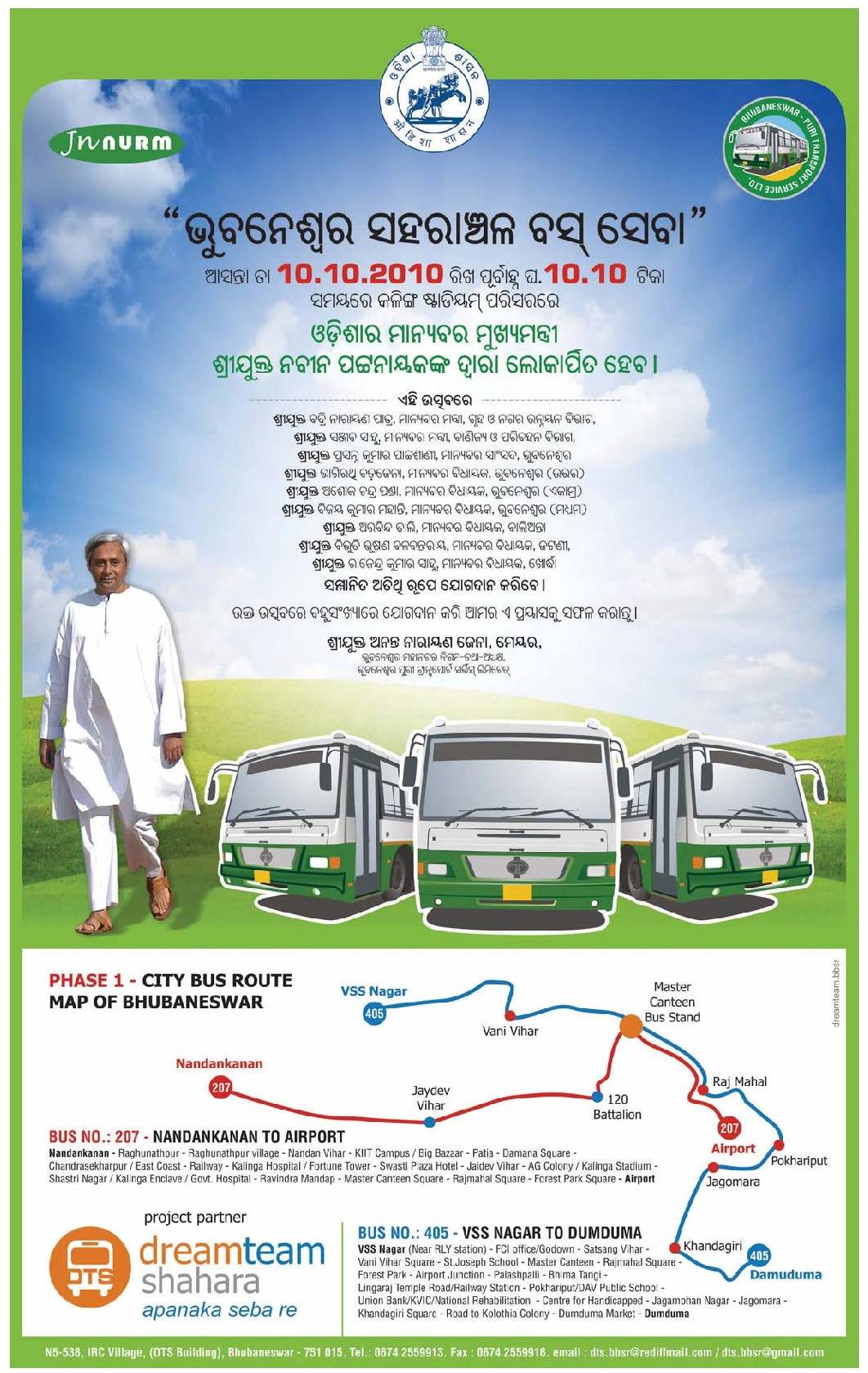
.png)
